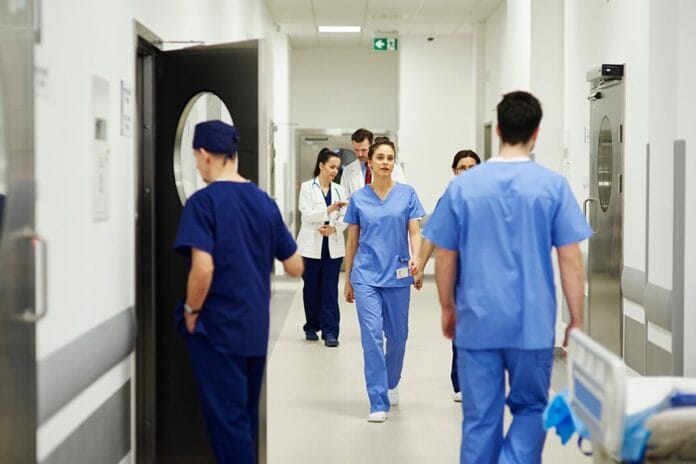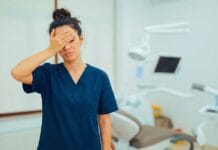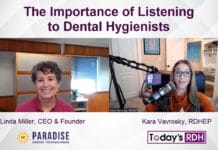Dental hygienists have long been utilized in alternative practice settings to provide oral care to those who would otherwise not receive it. By utilizing an advanced practice or expanded practice permit, hygienists can provide services in various settings, including schools, rehabilitation facilities, hospitals, and medical clinics. This area continues to expand as more public health organizations attempt to bridge the gap between medical and dental services.
Having a dental hygienist in a hospital setting is a newly emerging area of practice. The integration of oral health services in a hospital setting has arisen out of necessity due to the number of nontraumatic dental emergencies, dental pain, and hospital-acquired infections. A few states employ hygienists to provide care in hospitals, such as Oregon, Minnesota, and Arizona.
There are several different models when developing a medical-dental integration program in a hospital setting. One option could be for the hospital to employ the hygienist itself, another could be employment by a dental organization that contracts with the hospital, or they could be an independent practitioner who has gained privileges to provide services on-site.
So, what does it look like to have a dental hygienist serve different departments in a hospital?
Emergency Department
Over two million patients are seen in the emergency department (ED) each year for nontraumatic dental problems.1 These patients frequently present for dental pain, often because they lack access to a dental provider for preventive or regular care. They seek ED services either because they do not have an established dental home, they were unable to be seen by their existing provider, or a medical professional referred them due to symptoms of infection.
Patients with dental problems will go to the ED and be seen by a physician, and they are typically prescribed antibiotics and pain medications and then sent away.1 As a physician told me, “We spend about one day learning about oral health.” This lack of education on oral care is echoed by various professions in the medical community, including nurses, physician assistants, and CNAs.
Although this is unfortunate, it is ultimately the only option for some patients. One might think that they should stop prescribing antibiotics, as we are all aware of how antibiotics for dental infections can contribute to bacterial resistance. Yet, the doctors can’t do much else. One might also discourage pain medications. However, many patients have already taken the maximum recommended dose of ibuprofen and/or acetaminophen. Without some sort of intervention, the patient will likely return to the ED, requiring additional time, finances, and resources. This forces physicians to do the only things they can, which are typically not ideal.
To fill this gap, dental hygienists possess clinical knowledge of dental pain, infections, abscesses, fractured teeth, and oral conditions, including candidiasis, herpetic lesions, and stomatitis. After all, many of us report our findings of areas of concern during hygiene treatment to our dentists.
In an ED setting, dental hygienists are able to evaluate the mouth, perform limited testing on the tooth in question, and possibly provide some sort of relief. This can come in the form of a temporary restoration, silver diamine fluoride, or local anesthetic (depending on the scope of practice determined by the state). Hygienists can also take radiographs if necessary and provide an opinion on pain medications or antibiotics for a doctor to consider.
After the patient is adequately provided for, a hygienist may also help with care coordination. A patient in pain may need help getting a dental appointment since the ED treatment/response was probably unsuccessful. A dental hygienist calling from the ED with information and a radiograph of the tooth may be helpful in acquiring an emergent dental appointment.
Inpatient Care and Hospital-Acquired Pneumonia
In addition to the ED, dental hygienists can also provide care for inpatients. Hospital-acquired infections (HAI) can include catheter-associated UTIs, infection of surgical sites, C. difficile infections, and hospital-acquired pneumonia (HAP), which can be ventilator or non-ventilator-associated.2
Consistent oral care is the most studied measure in HAP prevention and stands as the only modifiable risk factor relevant to all patients. Although hospitals may have procedures and guidelines for administering oral care, it is often a missed part of patient care. Barriers to nurses providing oral care include being too busy due to staffing ratios, a lack of confidence in providing oral care, and a lack of oral care knowledge, including the misconception that oral care is a comfort measure rather than a preventive measure.3
Dental hygienists can play a large role in providing oral care to patients in acute care or intensive care units. In larger hospitals, a hygienist’s focus may be on implementing systemic changes, developing policies, and providing education. This can include ensuring that CNAs and nurses are educated on the importance of oral health and trained on how to evaluate the mouth and effectively remove food debris and biofilm with proper brushing, interdental cleaning, mouthrinse, and/or suction. They can also educate on the association between oral and systemic health, including its importance in HAP prevention.
In smaller hospitals with a lower patient load, a hygienist may be able to perform direct patient care. Their specialization in oral health and biofilm removal means patients experience more effective hygiene treatment, potentially leading to lower rates of HAP.4
Directly providing oral care to patients also allows a hygienist to perform oral assessments, oral cancer screenings, caries risk assessments, and oral hygiene instruction (OHI), followed by any necessary treatment (i.e., temporary restoration, SDF, local anesthetic). Because of the immense knowledge of biofilm removal techniques, not only will brushing and interdental cleaning be more effective when performed by hygienists, but if appropriate, more in-depth hygiene treatment may also be performed, such as prophylaxis or nonsurgical periodontal therapy.
Direct clinical interaction is also an excellent time to facilitate care coordination. This is typically achieved by establishing networks with local dentists and/or collaborating with public health resources. If patients do not have a dental home, they can be referred to a community location for a comprehensive oral evaluation and necessary treatment.
Additional Hospital Departments
In addition to the ED and inpatients at the hospital, a dental hygienist may also have access to other departments where they can provide preventive oral health services and OHI for those who need it most. These departments can include labor and delivery, OB/GYN, drug treatment and rehabilitation, cancer infusion, diabetes clinics, and pediatric departments.
Patients with diabetes may not understand the bidirectional association between oral health. Those who are about to undergo cancer treatments might not have developed a preventive dental treatment plan. Expectant mothers are given so much information on nutrition, prenatals, and pregnancy restrictions, yet are likely not provided with any recommendations on oral health.
Dental hygienists can be integrated into the patient workflow of these departments to effectively bridge these oral health gaps. This workflow may be accomplished in various ways depending on the hospital and the dental professional. The workflow can follow a consult-based approach, where medical professionals order specific services for patients based on certain conditions, or it can be a proactive approach, where the hygienist reviews patient lists to identify those who are appropriate for an evaluation.
Challenges for Medical-Dental Integration
The dental and medical fields have long been separate and not treated as a single entity. Although many professionals are trying to bridge this gap, our healthcare infrastructure presents numerous challenges that impede an individual’s ability to receive comprehensive care for their entire body. These challenges include inadequate cross-disciplinary training, systemic barriers that perpetuate a lack of oral health literacy among both patients and providers, and financial constraints, which may be the most significant barrier.5
Finances are obviously the foundation for any sort of program development, and without them, it may seem impossible to move forward.5 Funds are necessary to support personnel salary, necessary technology (i.e., radiology unit), and product acquisition, like toothbrushes, toothpaste, and floss.
Insurance and patient coverage also play a prominent role in ensuring a program is profitable and effective. A lack of dental insurance or reduced coverage for patients on Medicaid/Medicare, combined with suitable billing techniques for dental procedures, hinders the ability to be reimbursed for dental services and thus affects the long-term stability of any program.5
Although these barriers may seem insurmountable, dental professionals are a sturdy bunch, and we have seen remarkable progress toward our goals. This includes grants that subsidize integration efforts, insurance funding for dental positions in a medical setting, and the transition to value-based care in dentistry. We may have a great deal of work in front of us, but the progress that has already been made is undeniable.
In Closing
As we continue to advocate for the integration of dental health into overall health, having dental hygienists in medical facilities is one effective way to achieve this goal. Building relationships with physicians, respiratory therapists, nurses, speech-language pathologists, and other hospital personnel improves our collaborative efforts to provide patients with the best possible care they can receive.
Before you leave, check out the Today’s RDH self-study CE courses. All courses are peer-reviewed and non-sponsored to focus solely on high-quality education. Click here now.
Listen to the Today’s RDH Dental Hygiene Podcast Below:
References
- Giannouchos, T.V., Reynolds, J., Damiano, P., Wright, B. Association of Medicaid Expansion with Dental Emergency Department Visits Overall and by States’ Medicaid Dental Benefits Provision. BMC Health Serv Res. 2023; 23(1): 625. https://pmc.ncbi.nlm.nih.gov/articles/PMC10262360/
- Monegro, A.F., Muppidi, V., Regunath, H. (2023, February 12). Hospital Acquired Infections. StatPearls. https://www.ncbi.nlm.nih.gov/books/NBK441857/
- Munro, S., Baker, D. Reducing Missed Oral Care Opportunities to Prevent Non-Ventilator Associated Hospital Acquired Pneumonia at the Department of Veterans Affairs. Appl Nurs Res. 2018; 44: 48-53. https://pubmed.ncbi.nlm.nih.gov/30389059/
- Baker, D., Giuliano, K., Thakkar-Samtani, M., et al. The Association between Accessing Dental Services and Nonventilator Hospital-Acquired Pneumonia among 2019 Medicaid Beneficiaries. Infection Control and Hospital Epidemiology. https://www.ncbi.nlm.nih.gov/pmc/articles/PMC10262156/
- Fellows, J.L., Atchison, K.A., Chaffin, J., et al. Oral Health in America: Implications for Dental Practice. J Am Dent Assoc. 2022; 153(7): 601-609. https://jada.ada.org/article/S0002-8177(22)00211-2/fulltext










